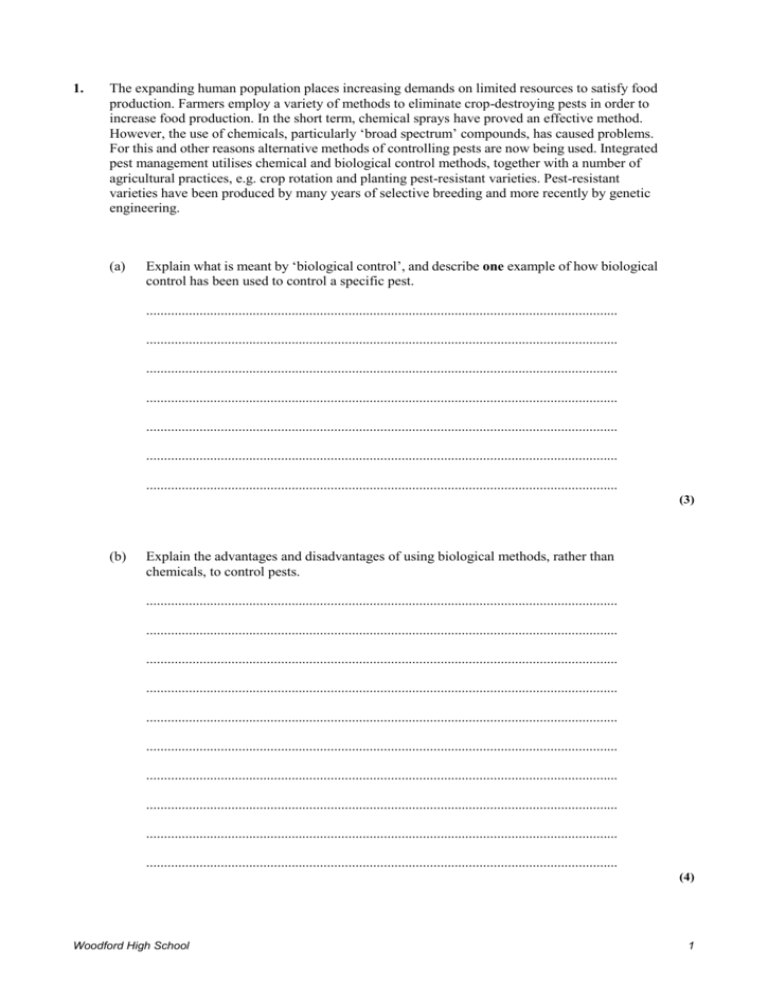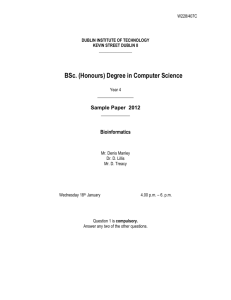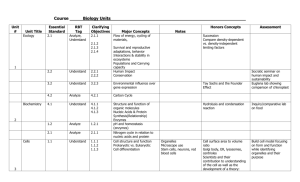Statements per question
advertisement

1. The expanding human population places increasing demands on limited resources to satisfy food production. Farmers employ a variety of methods to eliminate crop-destroying pests in order to increase food production. In the short term, chemical sprays have proved an effective method. However, the use of chemicals, particularly ‘broad spectrum’ compounds, has caused problems. For this and other reasons alternative methods of controlling pests are now being used. Integrated pest management utilises chemical and biological control methods, together with a number of agricultural practices, e.g. crop rotation and planting pest-resistant varieties. Pest-resistant varieties have been produced by many years of selective breeding and more recently by genetic engineering. (a) Explain what is meant by ‘biological control’, and describe one example of how biological control has been used to control a specific pest. ..................................................................................................................................... ..................................................................................................................................... ..................................................................................................................................... ..................................................................................................................................... ..................................................................................................................................... ..................................................................................................................................... ..................................................................................................................................... (3) (b) Explain the advantages and disadvantages of using biological methods, rather than chemicals, to control pests. ..................................................................................................................................... ..................................................................................................................................... ..................................................................................................................................... ..................................................................................................................................... ..................................................................................................................................... ..................................................................................................................................... ..................................................................................................................................... ..................................................................................................................................... ..................................................................................................................................... ..................................................................................................................................... (4) Woodford High School 1 (c) Briefly describe the process of genetic engineering and suggest one advantage it has compared to selective breeding. ..................................................................................................................................... ..................................................................................................................................... ..................................................................................................................................... ..................................................................................................................................... ..................................................................................................................................... ..................................................................................................................................... ..................................................................................................................................... ..................................................................................................................................... ..................................................................................................................................... ..................................................................................................................................... (5) (Total 12 marks) 2. Answers should be written in continuous prose. Credit will be given for biological accuracy, the organisation and presentation of the information and the way in which the answer is expressed. Cancer may be treated by chemotherapy. This involves using drugs which kill cancer cells but have no effect on normal healthy cells. Unfortunately. cancer cells develop from normal cells so the two types of cell are similar to each other. Trials have begun which involve adding a new gene to the normal cells in the body. This gene makes a protein which protects these healthy cells against the drug being used. The cancer cells do not produce this protein. so they are killed. (a) Describe the features of a gene which enable it to code for a particular protein. ................................................................................................................................... ................................................................................................................................... ................................................................................................................................... ................................................................................................................................... ................................................................................................................................... (4) (b) Explain how enzymes and vectors may be used to isolate genes and insert them into another organism. ................................................................................................................................... Woodford High School 2 ................................................................................................................................... ................................................................................................................................... ................................................................................................................................... ................................................................................................................................... (6) (c) Describe how the new protein is made once the gene has been inserted into the cell. ................................................................................................................................... ................................................................................................................................... ................................................................................................................................... ................................................................................................................................... ................................................................................................................................... (7) (QWC 3) (Total 20 marks) 3. (a) Describe how a particular gene can be removed from the DNA of an animal cell. ..................................................................................................................................... ..................................................................................................................................... ..................................................................................................................................... ..................................................................................................................................... (2) Woodford High School 3 (b) Describe how this gene can then be inserted into the genetic material of a bacterium. ..................................................................................................................................... ..................................................................................................................................... ..................................................................................................................................... ..................................................................................................................................... ..................................................................................................................................... ..................................................................................................................................... ..................................................................................................................................... (4) (Total 6 marks) 4. Some organisms are adapted for living in hot, dry environments. Explain what causes the activity of reptiles living in a desert to vary greatly over a twenty-four hour period. ............................................................................................................................................... ............................................................................................................................................... ............................................................................................................................................... ............................................................................................................................................... ............................................................................................................................................... ............................................................................................................................................... ............................................................................................................................................... ............................................................................................................................................... ............................................................................................................................................... ............................................................................................................................................... (Total 5 marks) Woodford High School 4 5. Homeostatic mechanisms maintain a constant environment in the body. (a) The graph shows changes in plasma glucose concentration that occurred in a person who went without food for some time. No food from this point on Plasma glucose concentration Time Key Change in this period due to glucagon Change in this period due to insulin Woodford High School 5 Use evidence from the graph to explain the role of negative feedback in the control of plasma glucose concentration. ………………………………………………………………………………………. ………………………………………………………………………………………. ………………………………………………………………………………………. ………………………………………………………………………………………. ………………………………………………………………………………………. ………………………………………………………………………………………. ………………………………………………………………………………………. ………………………………………………………………………………………. ………………………………………………………………………………………. ………………………………………………………………………………………. ………………………………………………………………………………………. ………………………………………………………………………………………. (5) (b) (i) Explain how normal core body temperature is maintained when a person moves into a cold room. ............................................................................................................................ ............................................................................................................................ ............................................................................................................................ ............................................................................................................................ ............................................................................................................................ ............................................................................................................................ ............................................................................................................................ ............................................................................................................................ ............................................................................................................................ ............................................................................................................................ (5) S (ii) How does maintaining a constant body temperature allow metabolic reactions in cells to proceed with maximum efficiency? Woodford High School 6 ............................................................................................................................ ............................................................................................................................ ............................................................................................................................ ............................................................................................................................ ............................................................................................................................ ............................................................................................................................ ............................................................................................................................ ............................................................................................................................ ............................................................................................................................ ............................................................................................................................ (5) (Total 15 marks) 6. (a) What is meant by reproductive isolation? ..................................................................................................................................... ..................................................................................................................................... ..................................................................................................................................... (1) Woodford High School 7 (b) Explain how geographical isolation can lead to the formation of new species. ..................................................................................................................................... ..................................................................................................................................... ..................................................................................................................................... ..................................................................................................................................... ..................................................................................................................................... ..................................................................................................................................... ..................................................................................................................................... ..................................................................................................................................... (4) (Total 5 marks) Woodford High School 8 7. (a) Substances found in fallen leaves contain the elements carbon and nitrogen. Explain how the activities of decomposers and nitrifying bacteria recycle the substances in fallen leaves for re-use by the trees. ..............................................................................................................…..................... ..............................................................................................................…..................... ..............................................................................................................…..................... ..............................................................................................................…..................... ..............................................................................................................…..................... ..............................................................................................................…..................... ..............................................................................................................…..................... ..............................................................................................................…..................... ..............................................................................................................…..................... ..............................................................................................................…..................... ..............................................................................................................…..................... ..............................................................................................................…..................... ..............................................................................................................…..................... ..............................................................................................................…..................... ..............................................................................................................…..................... ..............................................................................................................…..................... (7) (b) Explain how the felling and burning of trees on a large scale could affect the concentration of carbon dioxide in the atmosphere. ..............................................................................................................…..................... ..............................................................................................................…..................... ..............................................................................................................…..................... ..............................................................................................................…..................... ..............................................................................................................…..................... ..............................................................................................................…..................... (2) (c) Both rapidly-growing softwood trees and slow-growing hardwood trees grow in tropical rainforests. The seeds of both kinds of tree lie dormant on the floor of a mature forest and Woodford High School 9 only germinate when exposed to light and warmth. However, the seedlings of many hardwood species grow more successfully beneath the protective canopy of the softwood trees. When a small area of trees has been cut down, it can return naturally to tropical rainforest. Suggest and explain how re-establishment of the rainforest ecosystem may occur in such areas. ..............................................................................................................…..................... ..............................................................................................................…..................... ..............................................................................................................…..................... ..............................................................................................................…..................... ..............................................................................................................…..................... ..............................................................................................................…..................... ..............................................................................................................…..................... ..............................................................................................................…..................... ..............................................................................................................…..................... ..............................................................................................................…..................... ..............................................................................................................…..................... ..............................................................................................................…..................... ..............................................................................................................…..................... ..............................................................................................................…..................... (6) (Total 15 marks) Woodford High School 10 8. (a) Photosynthesis generally takes place in a leaf. Describe how the leaf is adapted to allow this process to occur effectively. .................................................................................................................................... .................................................................................................................................... .................................................................................................................................... .................................................................................................................................... .................................................................................................................................... .................................................................................................................................... .................................................................................................................................... .................................................................................................................................... (3) (b) Explain the roles of water, light and ribulose bisphosphate in the process of photosynthesis. (i) Water ........................................................................................................................... ........................................................................................................................... ........................................................................................................................... ........................................................................................................................... ........................................................................................................................... (ii) Light ........................................................................................................................... ........................................................................................................................... ........................................................................................................................... ........................................................................................................................... ........................................................................................................................... Woodford High School 11 (iii) Ribulose bisphosphate ........................................................................................................................... ........................................................................................................................... ........................................................................................................................... ........................................................................................................................... ........................................................................................................................... (6) (c) Explain why an increase in temperature will increase the rate of photosynthesis. .................................................................................................................................... .................................................................................................................................... .................................................................................................................................... .................................................................................................................................... .................................................................................................................................... .................................................................................................................................... .................................................................................................................................... (3) (Total 12 marks) 9. Read the following passage. Madagascar The island of Madagascar has been described as the laboratory of evolution. It broke away from mainland Africa at least 120 million years ago and, following this, many new species developed. Estimates of the number of plant species on the island vary from 7 370 to 12 000, making it botanically one of the richest areas in the world. Of 400 flowering plant families found worldwide, 200 grow only in Madagascar. Among animals, true lemurs are found nowhere else, and 95 per cent of the country’s 235 known species of reptiles evolved on the island. Over the past 25 years the human population has doubled. Land shortage is leading to clearing of the forest, and Madagascar is now facing deforestation on a massive scale. Scientists have estimated that even if the forest could recover, regeneration could take up to a hundred years. (Reproduced with permission from New Scientist magazine RBI Ltd) (a) Explain what is meant by the term species. .................................................................................................................................... Woodford High School 12 .................................................................................................................................... (2) (b) (i) Explain the processes which might have led to the evolution of new species on the island. ........................................................................................................................... ........................................................................................................................... ........................................................................................................................... ........................................................................................................................... ........................................................................................................................... ........................................................................................................................... ........................................................................................................................... ........................................................................................................................... (4) (ii) Suggest and explain how the number of animal species on the island may have changed as it became ‘botanically one of the richest areas in the world’. ........................................................................................................................... ........................................................................................................................... ........................................................................................................................... ........................................................................................................................... (2) Woodford High School 13 (c) Describe the processes by which forest is able to regenerate after being cleared. .................................................................................................................................... .................................................................................................................................... .................................................................................................................................... .................................................................................................................................... .................................................................................................................................... .................................................................................................................................... .................................................................................................................................... .................................................................................................................................... (4) (Total 12 marks) 10. 5 10 15 Read the following passage. In common with many other lakes and rivers, the waterways of the Norfolk Broads receive much of their phosphate from human excreta. Additional contributions come from intensive farming units. Since a pig and a cow respectively produce about 11 and 20 times as much phosphate per day as a human, the waste produced by such a unit is highly enriched. Consequently, if pig or cattle waste is allowed to escape into a nearby ditch, the amount of phosphate in the receiving watercourse will increase dramatically. If, as is often the case, the ditch runs through drained marshland, the aquatic organisms near the point of entry will be killed. However, by the time the polluted water reaches a stream or river, the sediment will have taken up much of the phosphate and its overall effect will be slight in comparison to sewage treatment works which discharge directly into rivers. In addition it needs to be borne in mind that a pig produces about 500 kg of organic matter a year, and a cow four times as much. This compares with 43 kg generated each year by a human. As a consequence, an accidental discharge of farmyard waste may result in the death of fish and other forms of wildlife either through a lack of oxygen or because of a build-up of nitrites which are poisonous to invertebrates and fish. It is also likely to bring about a decrease in the diversity of the invertebrate animals. (Adapted from: The Land Use, Ecology and Conservation of Broadland by Dr. Martin George by permission of Packard Publishing Limited). Woodford High School 14 (a) Suggest how the addition of organic matter to water in an accidental discharge of farmyard waste (line 14) may result in (i) a lack of oxygen; ........................................................................................................................... ........................................................................................................................... ........................................................................................................................... ........................................................................................................................... ........................................................................................................................... ........................................................................................................................... (3) (ii) an increase in nitrites. ........................................................................................................................... ........................................................................................................................... ........................................................................................................................... ........................................................................................................................... ........................................................................................................................... ........................................................................................................................... (3) Woodford High School 15 (b) The amount of phosphate produced per day by pigs and cattle is much higher than that produced by humans but causes less damage to the environment. Use the passage and your own knowledge to explain why less damage is done to the environment. .................................................................................................................................... .................................................................................................................................... .................................................................................................................................... .................................................................................................................................... .................................................................................................................................... .................................................................................................................................... .................................................................................................................................... (4) (Total 10 marks) 11. Read the following passage. Japan may finally swallow the Pill Three decades after the rest of the industrialised world, Japan has begun its final deliberations on whether to introduce contraceptive pills. Although they are currently banned in Japan, contraceptive pills are expected to be approved by government officials in June. The official explanation for the delay is that there are some concerns that oral contraceptives might encourage people to give up using condoms. However, many observers think that the real reasons behind the delay include the government’s fears of a shrinking population. Women in Japan now have on average only 1.4 children each, one of the lowest rates in the world. Woodford High School 16 The graphs show projections for the size of the Japanese population and the proportion of the population aged 65 and over. Estimated population size/millions 130 125 120 115 110 105 100 2000 2010 2020 2030 2040 2050 Year 40 Percentage of population 30 20 aged 65 10 and over 0 2000 2010 2020 2030 2040 2050 Year (Reproduced with permission from New Scientist magazine RBI Ltd) (a) Explain how oral contraceptives containing progesterone and oestrogen work. .................................................................................................................................... .................................................................................................................................... .................................................................................................................................... .................................................................................................................................... .................................................................................................................................... .................................................................................................................................... .................................................................................................................................... .................................................................................................................................... .................................................................................................................................... (5) Woodford High School 17 (b) Use the information given to evaluate the concerns about introducing oral contraceptives in Japan. .................................................................................................................................... .................................................................................................................................... .................................................................................................................................... .................................................................................................................................... .................................................................................................................................... .................................................................................................................................... (3) (c) Assuming that the projected figures shown in the graph are accurate, explain how you would expect the population pyramid for Japan in 2050 to differ from that for 2000. .................................................................................................................................... .................................................................................................................................... .................................................................................................................................... .................................................................................................................................... .................................................................................................................................... .................................................................................................................................... .................................................................................................................................... .................................................................................................................................... (4) (Total 12 marks) Mark Scheme (a) using a predator / parasite / pathogen to control (the numbers of) a pest organism; Woodford High School 18 name of control organism and pest; explanation of control method; (b) advantages (max 3) (if well-screened) a biological control agent only attacks the pest; forms self-perpetuating population (only one application required); cheaper (qualified) e.g. saves cost of repeatedly using chemicals; safer because does not leave chemical residue; organisms do not become resistant to biological control; disadvantages (max 3) doesn’t completely eradicate pest; cost of researching / setting up a biological control system; biological control agent may become a nuisance itself/must be well screened; slower to get rid of pest than chemicals; more subject to environmental factors; (c) 3 use of restriction / endonuclease enzyme; cuts DNA at specific base sequence / recognition site; reference to vector / method of inserting DNA; same endonuclease to cut vector/host DNA; use of ligase enzyme (to join DNA strands); (allow equivalent mark points for use of reverse transcript) any 4 max. 4 one mark for advantage of genetic engineering e.g. much quicker / more efficient / several genes can be inserted at once; [12] 2.a) Gene is a (length) of DNA; Gene is a sequence of bases/chain of nucleotides; Triplet (base) code/read in three’s; On sense/coding strand; Triplet coding for amino acid; Degenerate code; non-overlapping; start/stop code; Sequence of triplets/bases code for protein; (b) (c) max 4 Restriction enzymes; Cut DNA; at specific base sequences; Same (restriction) enzyme also cuts DNA; into which gene is inserted/plasmid/virus/Agrobacterium; (DNA) ligase; Joins two pieces of DNA together/forms recombinant DNA; Vector needed to insert DNA into host/plasmid enters host/second organism; Correct ref. to sticky ends; Reverse transcriptase; mRNA DNA; max 6 Unwinding/unzipping of DNA; involving breaking of hydrogen bonds; Assembly of mRNA nucleotides; Complementary base pairing/example; Role of polymerase enzymes; mRNA enters ribosomes; Specific tRNA molecule associated with specific amino acid; Codon - anticodon relationship; Formation of peptide bonds; Specific role of ATP/energy; Reference to gene switched on; max 7 Quality of language Woodford High School 19 Aspect of work Grammar, punctuation and spelling of an acceptable standard 1 Material presented in an appropriate scientific style with due regard to correct use of technical terms 1 Argument clearly and logically presented 1 [20] 3. (a) Locate with the use of a gene probe; Use restriction enzymes / endonucleases; To cut at specific base sequence; By hydrolysing / breaking sugar-phosphate bonds; 2 (b) Same restriction enzymes; Cut at same base sequence in bacterial DNA; Leaving sticky ends / hydrogen bonds break; Join / splice with ligase; Use of plasmid; max max 4 [6] 4. Quality of Communication The answers to all sections of this question require the use of continuous prose. Quality of language should be considered in crediting points in the scheme. In order to gain credit, answers should be expressed logically and unambiguously, using scientific terminology where appropriate. Reptiles are ectotherms; [Reject: cold blooded] Body temperature varies with that of environment, Temperature of desert fluctuates greatly over 24 hours; Metabolic reactions controlled by enzymes; Enzyme activity/ metabolic rate changes with body temperature; Speed of bodily actions dependent on metabolic rate/ enzyme activity; Reptiles seek shade/ water when hot/ reduce contact with hot surface; Seek sun when cool; max 5 [5] 5.Quality of Communication The answers to all sections of this question require the use of continuous prose. Quality of language should be considered in crediting points in the scheme. In order to gain credit, answers should be expressed logically and unambiguously, using scientific terminology where appropriate. (a) 1. Deviation of a value from norm initiates corrective mechanisms; 2. fluctuations in plasma glucose concentration detected by hypothalmus/islet cells in pancreas; 3. initial decrease, no food given (in plasma glucose) stimulates (increased) secretion of glucagon; 4. increases (in plasma glucose) stimulate (increased) secretion of insulin; Woodford High School 20 5. correct ref. to role of and/or cells as secretors; 6. correct ref. to interconversion of glycogen / glucose; 7. increased/decreased uptake of glucose by cells (as appropriate)/correct ref to change in membrane permeability; (b) (i) (ii) max 5 1. Sensors in skin/hypothalmus detect reduced temperature; 2. heat gain centre activated/inhibition of heat loss centre; 3. vasoconstriction/constriction of arterioles in skin surface; (R capillaried) 4. dilation of shunt vessels/constriction of – capillary sphincter; 5. less blood to skin surface/capillaries 6. reduced heat loss by radiation; 7. incresed heat gain by increased metabolic rate/respiration/ movement/shivering; 8. decreased heat loss by putting on clothes/huddling/reduced sweating; max 5 1. Body temp./37°C is optimum temp for enzymes; 2. excess heat denatures enzymes/alters tertiary structure/alters shape of active site/enzyme; 3. substrate cannot bind/eq,; 4. reactions cease/slowed; 5. too little reduces kinetic energy of molecules / molecules move more slowly; 6. fewer collisions/fewer ES complexes formed’ max 5 [15] 6. (a) Organisms cannot interbreed/ breed or mate or reproduce with another group/ incompatible gametes/ wrong courtship behaviour/ other valid; (b) 1 Populations separated by physical barrier/ example; 2 No mixing of gene pools; 3 Different selection pressures; 4 Become adapted to local environment; 5 Survive and reproduce; 6 Mutation in one group (different from other group); 7 Change in allele frequencies; [Reject: Gene] 8 Isolated populations/ new species cannot interbreed; 1 max 4 [5] 7. Quality of Communication The answers to all sections of this question require the use of continuous prose. Quality of language should be considered in crediting points in the scheme. In order to gain credit, answers should be expressed logically and unambiguously, using scientific terminology where appropriate. (a) (Decomposers): Secretaion/release of enzymes; [REJECT ‘excrete] Digest/hydrolyse organic matter; Absorption /’taken in’ – by named process e.g. diffusion/active transport; (ALLOW ‘endocytosis) Respiration Release carbon dioxide; Carbon dioxide used in photosynthesis; Release ammonia/ammonium salts/ions/mineral salts/nutrients; (ALLOW named small organic molecules) (Nitrifying bacteria): Woodford High School Ammonia/ammonium to nitrate; 21 Nitrate to nitrate; OR ammonia nitrate = 1mk Aerobic/use of oxygen/by oxidation; [ALLOW correct symbols] Nitrates/nitrites/ammonium used in synthesis of amino acids/protein /nucleic acids/other correct organic –N; (b) (Increase in carbon dioxide because) – Burning releases carbon dioxide; [IGNORE ref. to felling] Less carbon dioxide removed by trees/less removed in photosynthesis; (c) max 7 2 1. 2. 3. 4. 5. 6. Cleared areas light/tree seeds germinate/grow in light; Light for photosynthesis; Softwoods compete for light; Hardwoods can grow in low light; Additional seeds from close/adjacent areas; Less water evaporation (from hardwood seedlings) /maintains humididy 7. Less extremes of temperature; /maintains microclimate; 8. (canopy) reduces impact of rainfall (on hardwood seedlings)/ref. ‘torrential; 9. roots stabilise soil / less soil erosion (by rainfall); 10. less leaching (of ions)(by rainfall); 11. litter fall recycling of ions (for hardwood seedlings); 12. (Trees) provide food for animals; 13. (Trees) provide habitats/niches/cover/shelter/nest sites for animals; 14. Correct ref to succession / climax established; max 6 [15] 8. (a) Large surface area to collect solar energy; transparent nature of cuticle to allow light penetration; position of chlorophyll to trap light; stomata to allow exchange of gases; thin / max. surface area to volume ratio for diffusion of gases; spongy mesophyll / air spaces for carbon dioxide store; xylem for input of water; phloem for removal of end products; max .3 (b) (i) (ii) (iii) (c) water: provides hydrogen; to reduce NADP; provides electron; to stabilise / reduce chlorophyll; max. 2 light : excites / oxidises / removes an electron from chlorophyll / photosystem; photophosphorylation / ATP produced; electron used in reduction of NADP; max. 2 Ribulose bisphosphate: carbon dioxide acceptor; forms GP; max. 2 Enzymes are involved; extra kinetic energy / molecules move faster; molecules collide more often / more enzyme - substrate complexes Woodford High School 22 formed; increased rate of diffusion of raw materials; max. 3 [12] 9. (a) similar characteristics / physically similar / DNA similar; breed among themselves; to produce fertile offspring; do not share same ecological niche with any other species; (b) (b) (c) (i) (ii) max 2 isolation; no gene flow between populations; variation; different environmental factors; natural selection / selection for specific alleles / characteristics; change in allele / phenotype frequency; changes over a long period of time; max 4 more habitats / niches; more / greater range of food for herbivores; more / greater range of food for carnivores / predators; more detritus; max 2 colonisation / description e.g. seeds blown in / pioneer species;~ succession; alteration of habitat / more humus / deeper soil; development of herbaceous / field layer; followed by shrub layer; max 4 [12] 10. (a) (i) Decomposition/breakdown of organic material/decomposers; Bacteria; Oxygen used in bacterial respiration; (ii) (b) Organic material broken down to ammonia; nitrifying bacteria; convert ammonia to nitrite; Excretory material produced by pigs and cattle absorbed by sediment; Only a little reaches water courses; Localised effect; Human sewage collected from many people/wide area; Discharged into larger water courses; Contains waste from other sources; Includes phosphate from detergents; 3 3 max 4 [10] 11. (a) Oestrogen inhibits FSH; prevents follicle developing; progesterone inhibits LH; also inhibits FSH; Woodford High School 23 (b) (c) inhibits ovulation; FSH and LH bring about ovulation max 5 Condoms protect against sexually transmitted diseases; oral contraceptives very reliable; more likely to contribute to falling birth rate; demographic effects of falling birth rate max 3 Narrower base; indicating fewer children; base not widest part; wider top; indicating more older people; 2050 pyramid smaller in area than pyramid for 2000 max 4 [12] Woodford High School 24










